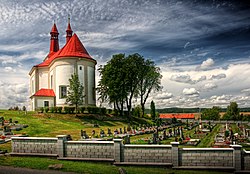world.wikisort.org - Czech
Bělotín (German: Bölten) is a municipality and village in Přerov District in the Olomouc Region of the Czech Republic. It has about 1,800 inhabitants.
Bělotín | |
|---|---|
Municipality | |
 Church of Saint George | |
 Flag  Coat of arms | |
 Bělotín Location in the Czech Republic | |
| Coordinates: 49°35′28″N 17°48′24″E | |
| Country | |
| Region | Olomouc |
| District | Přerov |
| First mentioned | 1201 |
| Area | |
| • Total | 33.39 km2 (12.89 sq mi) |
| Elevation | 297 m (974 ft) |
| Population (2022-01-01)[1] | |
| • Total | 1,793 |
| • Density | 54/km2 (140/sq mi) |
| Time zone | UTC+1 (CET) |
| • Summer (DST) | UTC+2 (CEST) |
| Postal code | 753 64 |
| Website | www |
Administrative parts
Villages of Kunčice, Lučice and Nejdek are administrative parts of Bělotín.
Geography
Bělotín is located about 29 kilometres (18 mi) northeast of Přerov and 38 km (24 mi) east of Olomouc. It lies in the Moravian Gate lowland.
History
The first written mention of Bělotín is from 1201. The village was founded in the second half of the 12th century. Until the German colonization in the 14th century, the population was purely Slavic.[2]
Until the turn of the 14th and 15th centuries, Bělotín was owned by the Hradisko Monastery as a part of the Hranice estate. In 1475, the estate was acquired by the Pernštejn family, then it was sold to the Haugvic of Biskupice family in 1548. After it changed its owners several times, the estate was confiscated after the Battle of White Mountain and donated to Franz von Dietrichstein. His house held Bělotín and the whole Hranice estate until 1858.[2]
During World War II, Bělotín was incorporated by Nazi Germany to Reichsgau Sudetenland, and it was the base for a detached Work Camp E540 (Arbeitskommando E540) for British and Commonwealth prisoners of war, under the administration of the Stalag VIII-B/344 prisoner-of-war camp at Łambinowice.[3] In January 1945, as the Soviet armies resumed their offensive and advanced from the east, the prisoners of the whole Stalag VIII-B/344 POW camp were marched westward in the Long March.
Transport
Bělotín lies on a railway line of local importance Hranice–Studénka.
The D1 motorway and its branch D48 motorway run through the municipality.
Sights
The landmark of Bělotín is the Church of Saint George. This Baroque church dates from 1754 and has a Renaissance tower. The second cultural monument in the municipality is the cemetery Church of Saint Urban in Nejdek from 1752.[4]
Twin towns – sister cities
Bělotín is twinned with:[5]
 Hinterschmiding, Germany
Hinterschmiding, Germany Höchst im Odenwald, Germany
Höchst im Odenwald, Germany Kolonowskie, Poland
Kolonowskie, Poland
References
- "Population of Municipalities – 1 January 2022". Czech Statistical Office. 2022-04-29.
- "Historie Bělotína" (in Czech). Obec Bělotín. Retrieved 2022-02-07.
- "Working Parties". Lamsdorf.com. Archived from the original on 29 October 2020. Retrieved 12 November 2021.
- "Památky a významné stavby" (in Czech). Obec Bělotín. Retrieved 2022-02-07.
- "Main Page: Partneři" (in Czech). Obec Bělotín. Retrieved 2022-02-07.
External links
На других языках
[de] Bělotín
Bělotín (deutsch Bölten) ist eine Gemeinde in Tschechien. Sie liegt sechs Kilometer nordöstlich der Stadt Hranice na Moravě (deutsch Mährisch Weißkirchen) und gehört zum Okres Přerov (deutsch Kreis Prerau). Die Gemeinde Bölten war bis zur Besetzung durch die Rote Armee am 7. Mai 1945 ein deutsches Gemeinwesen. Der tschechische Bevölkerungsanteil betrug 1910 bei der letzten österreichischen Volkszählung 0,75 Prozent. 1946 wurden die Deutschen aus Bělotín vertrieben.- [en] Bělotín
Другой контент может иметь иную лицензию. Перед использованием материалов сайта WikiSort.org внимательно изучите правила лицензирования конкретных элементов наполнения сайта.
WikiSort.org - проект по пересортировке и дополнению контента Википедии